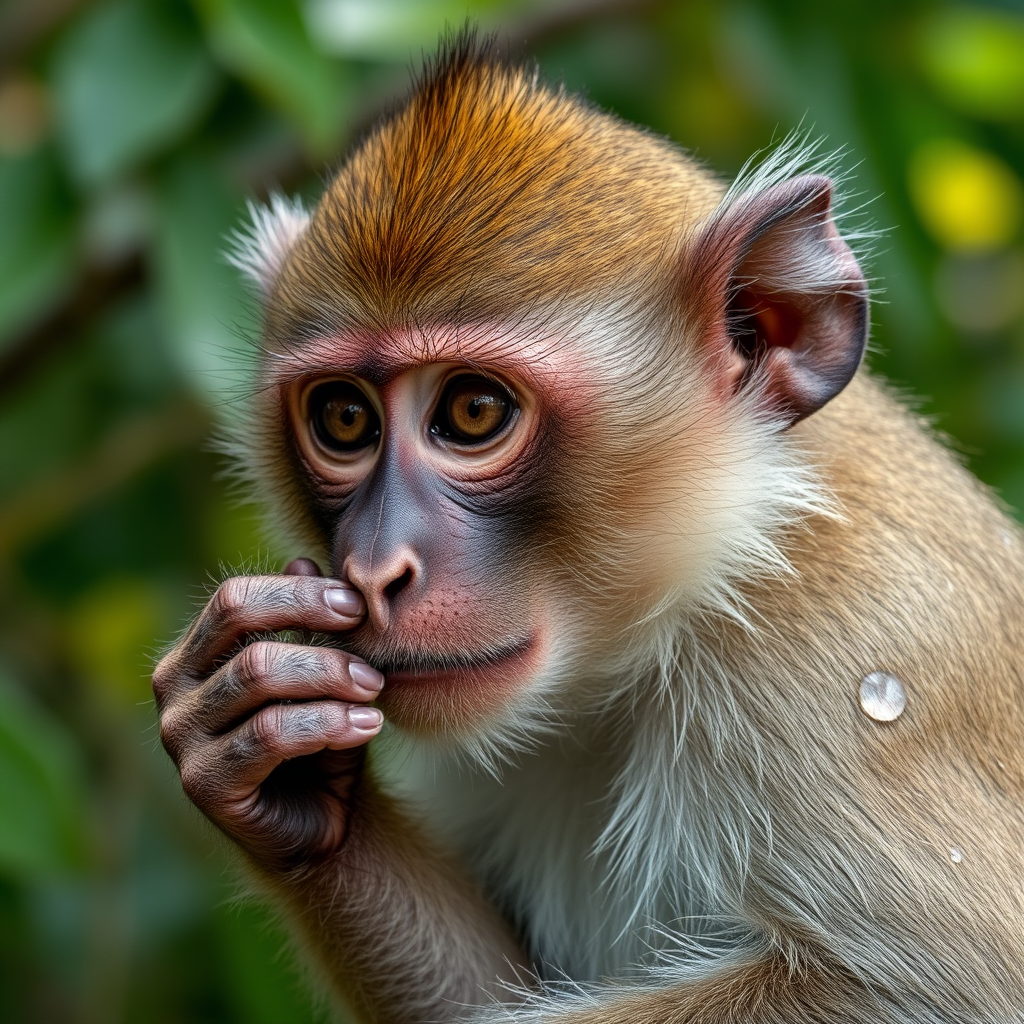Introduction
Monkeypox, a rare viral disease, has recently gained global attention due to its sudden and alarming spread in regions outside of Africa, where it is typically endemic. This disease, caused by the monkeypox virus, shares similarities with smallpox, a virus eradicated in 1980 through widespread vaccination efforts. Although less severe than smallpox, monkeypox presents significant public health challenges due to its potential for human-to-human transmission and its capacity to cause severe illness in some individuals.
Historically, monkeypox was first identified in 1958 when outbreaks of a pox-like disease occurred in laboratory monkeys kept for research, hence the name “monkeypox.” However, it wasn’t until 1970 that the first human case was recorded in the Democratic Republic of Congo. Since then, sporadic cases have been reported across Central and West Africa, particularly in rural areas near tropical rainforests where people have close contact with animals like rodents, which are believed to be the primary reservoirs of the virus.
In 2022, the world witnessed an unprecedented surge in monkeypox cases outside of Africa, leading to concerns about the disease’s potential to spread globally. The World Health Organization (WHO) and other public health agencies have since intensified efforts to understand and contain the outbreak. This has involved tracking cases, researching the virus’s transmission dynamics, and developing strategies for prevention and control. Public health responses have been crucial in curbing the spread, but the emergence of monkeypox as a global health concern underscores the need for continued vigilance and research.
This article delves into the various aspects of monkeypox, offering a detailed overview of the disease, its transmission, symptoms, diagnosis, treatment, and preventive measures. By exploring these facets, the article aims to provide a thorough understanding of monkeypox, addressing common questions and concerns associated with this disease.
Understanding Monkeypox: The Virus and Its Transmission
The Monkeypox Virus
Monkeypox is caused by the monkeypox virus, a member of the Orthopoxvirus genus, which also includes the variola virus (the causative agent of smallpox), the vaccinia virus (used in the smallpox vaccine), and the cowpox virus. The monkeypox virus has two distinct genetic clades: the Central African (Congo Basin) clade and the West African clade. The Congo Basin clade is known to cause more severe illness and is more transmissible than the West African clade.
The virus is a zoonotic pathogen, meaning it can be transmitted from animals to humans. The primary animal reservoirs of the monkeypox virus are believed to be rodents, including squirrels and rats, although monkeys and other animals can also carry the virus. The exact animal reservoir, however, remains unknown.
Transmission
Monkeypox is transmitted to humans through direct contact with the blood, bodily fluids, or skin or mucosal lesions of infected animals. In Africa, human infections have been documented through the handling of infected monkeys, Gambian pouched rats, and squirrels, with rodents being the most likely reservoirs. Secondary, or human-to-human, transmission can occur through close contact with respiratory secretions, skin lesions of an infected person, or recently contaminated objects.
The virus can enter the body through broken skin (even if not visible), the respiratory tract, or the mucous membranes (eyes, nose, or mouth). Human-to-human transmission is primarily through respiratory droplets, typically requiring prolonged face-to-face contact. It can also occur through direct contact with body fluids or lesion material, and indirect contact with lesion material, such as through contaminated clothing or linens.
Monkeypox is not as contagious as smallpox, and while transmission between people has been documented, sustained human-to-human transmission is relatively rare. Nevertheless, the recent outbreak in non-endemic countries has shown that monkeypox can spread more widely than previously thought, particularly in specific social networks and settings where close contact is common.
Symptoms and Clinical Presentation
Monkeypox symptoms typically appear 7 to 14 days after exposure to the virus, although the incubation period can range from 5 to 21 days. The illness begins with a prodrome, which includes fever, headache, muscle aches, back pain, swollen lymph nodes, chills, and exhaustion. One of the key distinguishing features of monkeypox from smallpox is the presence of swollen lymph nodes (lymphadenopathy), which is not seen in smallpox cases.

Progression of Symptoms
Following the prodromal stage, a rash usually appears within 1 to 3 days. The rash often begins on the face before spreading to other parts of the body, including the palms of the hands and the soles of the feet. The rash progresses through several stages before finally forming scabs that eventually fall off. The stages include:
- Macules: Flat, discolored spots on the skin.
- Papules: Raised, firm bumps.
- Vesicles: Small, fluid-filled blisters.
- Pustules: Pus-filled blisters.
- Scabs: Crusts that form over healing sores.
The rash typically lasts for 2 to 4 weeks. In severe cases, the lesions can coalesce, leading to large areas of skin sloughing off. The severity of the disease can vary, with some patients experiencing mild symptoms and others developing more severe illness, including complications such as secondary bacterial infections, bronchopneumonia, sepsis, encephalitis, and corneal infection with possible loss of vision.
Complications and Mortality
While most monkeypox infections are mild and self-limiting, the disease can be severe in some cases, particularly in children, pregnant women, and individuals with weakened immune systems. The case fatality ratio for monkeypox has varied widely across different outbreaks and is estimated to be between 1% and 10%, with the Congo Basin clade being more virulent than the West African clade.
Complications of monkeypox can include secondary bacterial infections, respiratory distress, gastrointestinal involvement, and encephalitis. In particular, the virus can cause severe eye infections that may result in vision loss if not properly treated. Additionally, in some cases, the virus can affect the lungs and lead to severe respiratory complications.
Diagnosis and Laboratory Testing
Diagnosing monkeypox can be challenging, especially in non-endemic regions where healthcare providers may not be familiar with the disease. The clinical presentation of monkeypox can resemble other diseases, such as chickenpox, smallpox, and certain sexually transmitted infections, making accurate diagnosis crucial.

Laboratory Confirmation
Laboratory testing is essential for confirming a suspected monkeypox case. The preferred diagnostic method is the detection of viral DNA using polymerase chain reaction (PCR) testing, typically from samples taken from skin lesions. The accuracy of PCR testing depends on the quality of the specimen and the timing of sample collection relative to the onset of the rash.
In addition to PCR, other laboratory methods such as viral culture, electron microscopy, and serological testing (detecting antibodies in the blood) can be used, though these methods are less commonly employed due to their complexity and the need for specialized laboratory facilities.
Treatment and Management
Currently, there is no specific antiviral treatment approved for monkeypox. However, several treatments used for other Orthopoxvirus infections, like smallpox, have shown potential in managing monkeypox cases. Treatment primarily focuses on alleviating symptoms, managing complications, and preventing long-term sequelae.
Supportive Care
Most patients with monkeypox recover with supportive care alone. This includes maintaining hydration, managing fever and pain, and treating secondary bacterial infections if they occur. Severe cases may require hospitalization, especially if complications such as respiratory distress or encephalitis develop.

Antiviral Medications
Several antiviral drugs have been investigated for their potential to treat monkeypox. Tecovirimat (TPOXX), an antiviral drug developed to treat smallpox, has shown efficacy against monkeypox in laboratory and animal studies and has been used under compassionate use protocols during outbreaks. Another antiviral, Brincidofovir, has also been considered, although its use has been limited due to concerns about potential side effects.
Vaccination
While there is no specific monkeypox vaccine, the smallpox vaccine has been found to be about 85% effective in preventing monkeypox. This cross-protection is due to the close relationship between the smallpox and monkeypox viruses. In response to recent outbreaks, some countries have begun using the smallpox vaccine for post-exposure prophylaxis in individuals at high risk of infection.
The newer, non-replicating smallpox vaccine, known as Modified Vaccinia Ankara (MVA), has been approved for use in several countries and is considered safer for individuals with weakened immune systems. This vaccine has been deployed in response to monkeypox outbreaks as both pre-exposure and post-exposure prophylaxis.
Prevention and Control
Preventing monkeypox requires a multi-faceted approach, particularly in regions where the disease is endemic. Public health measures focus on reducing the risk of animal-to-human transmission, preventing human-to-human transmission, and controlling outbreaks through vaccination and other strategies.
Preventing Zoonotic Transmission
In endemic regions, efforts to prevent zoonotic transmission include educating the public about the risks of handling wild animals, especially those that are sick or found dead. Public health campaigns emphasize the importance of avoiding contact with animals that could carry the virus, practicing good hand hygiene, and cooking all animal products thoroughly before consumption.
Preventing Human-to-Human Transmission
To prevent the spread of monkeypox between people, especially in the context of recent outbreaks, public health authorities recommend isolating infected individuals, practicing good respiratory hygiene, and using personal protective equipment (PPE) when caring for patients. Contact tracing and monitoring of those who have been exposed to the virus are critical components of outbreak control efforts.

Healthcare workers are advised to follow standard infection control procedures, including the use of gloves, masks, and eye protection when caring for patients with suspected or confirmed monkeypox. The use of vaccines as post-exposure prophylaxis is also recommended for individuals who have been in close contact with monkeypox patients.
Global Response to Monkeypox Outbreaks
The global response to monkeypox outbreaks has evolved significantly since the disease first emerged. International organizations, including the WHO, have played a central role in coordinating efforts to monitor, investigate, and respond to monkeypox outbreaks.
Surveillance and Reporting
Effective surveillance and reporting systems are essential for detecting and responding to monkeypox outbreaks. The WHO has established guidelines for surveillance, which include case definitions, laboratory testing protocols, and procedures for reporting cases. Countries are encouraged to strengthen their surveillance systems and report any suspected cases to the WHO to enable timely and coordinated responses.
Research and Development
Research into monkeypox is ongoing, with efforts focused on understanding the virus’s transmission dynamics, identifying effective treatments, and developing better vaccines. The recent outbreaks in non-endemic regions have highlighted the need for further research into the virus’s behavior in different populations and settings.
Public Health Campaigns
Public health campaigns play a vital role in educating the public about monkeypox and reducing the stigma associated with the disease. In recent outbreaks, misinformation and fear have contributed to social stigma, particularly in communities where the virus has spread. Clear, accurate communication from public health authorities is essential to counter misinformation and ensure that individuals understand the risks and take appropriate precautions.
Frequently Asked Questions About Monkeypox
1. How is monkeypox different from smallpox?
While monkeypox and smallpox are caused by viruses from the same family, monkeypox is generally less severe than smallpox. Monkeypox causes lymphadenopathy (swollen lymph nodes), which is not seen in smallpox. Additionally, the monkeypox virus is less transmissible and has a lower mortality rate compared to smallpox.
2. Can monkeypox be fatal?
Monkeypox can be fatal, especially in severe cases or among vulnerable populations such as children, pregnant women, and individuals with weakened immune systems. The case fatality rate varies by clade and region, ranging from 1% to 10%.
3. Is there a vaccine for monkeypox?
There is no specific monkeypox vaccine, but the smallpox vaccine has been shown to be effective in preventing monkeypox. Some countries have started using the smallpox vaccine for post-exposure prophylaxis during recent monkeypox outbreaks.
4. How can I protect myself from monkeypox?
To protect yourself from monkeypox, avoid contact with animals that may carry the virus, practice good hygiene, and avoid close contact with infected individuals. If you are in an area where monkeypox is spreading, consider getting vaccinated, especially if you are at high risk.
5. What should I do if I suspect I have monkeypox?
If you suspect you have monkeypox, seek medical attention immediately. Isolate yourself to prevent spreading the virus to others, and inform healthcare providers about your symptoms and any potential exposure to the virus.
6. Can monkeypox spread through sexual contact?
While monkeypox is not classified as a sexually transmitted infection, it can spread through close physical contact, including sexual activity. The virus can be transmitted through direct contact with lesions, body fluids, or respiratory droplets from an infected person.
Conclusion
Monkeypox, once a relatively obscure disease confined to specific regions in Africa, has emerged as a global public health concern. Its recent spread to non-endemic regions highlights the need for increased awareness, research, and preparedness. Although monkeypox is generally less severe than smallpox, it can cause significant illness and complications, particularly in vulnerable populations.
The global response to monkeypox has underscored the importance of surveillance, vaccination, and public health education in preventing and controlling outbreaks. As the world continues to grapple with the challenges posed by emerging infectious diseases, the lessons learned from the monkeypox outbreaks will be crucial in shaping future responses to similar public health threats.
Through continued research, vaccination efforts, and public health interventions, the spread of monkeypox can be curtailed, ensuring that this disease does not become a more widespread and entrenched public health problem. Understanding the dynamics of monkeypox transmission, the importance of early diagnosis, and the strategies for prevention and control will be key to managing this disease effectively in the future.
Best Reads





Very well presented. Every quote was awesome and thanks for sharing the content. Keep sharing and keep motivating others.
Fantastic site Lots of helpful information here I am sending it to some friends ans additionally sharing in delicious And of course thanks for your effort
Thanks a lot! Happy Reading